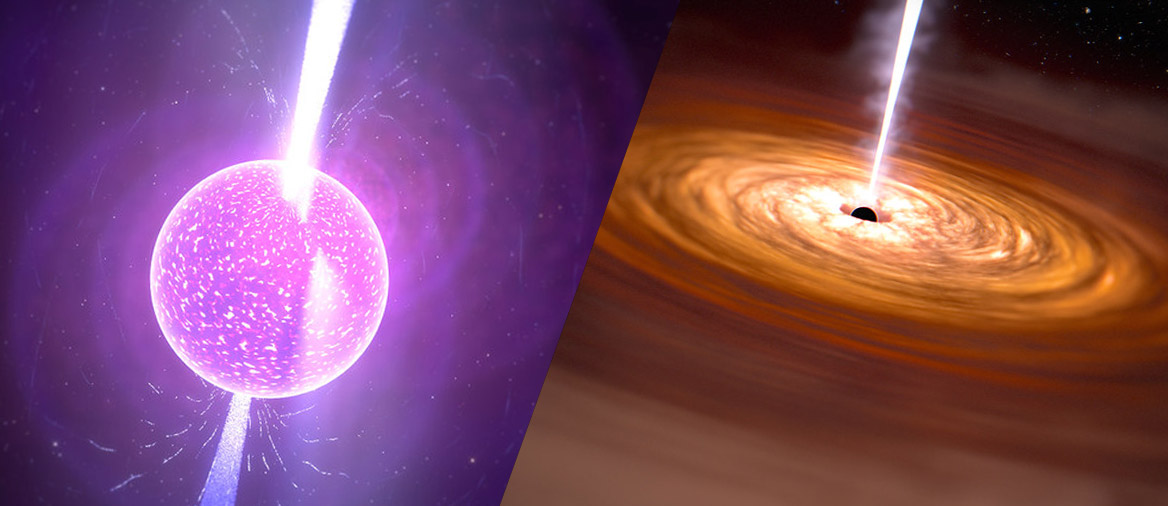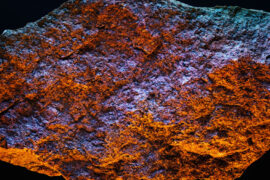Naming conventions in the scientific world can be weird. And sometimes you end up with two different types of objects that have nothing to do with each other but that have very similar names. Of course, when that happens, they can be confused with each other, and is hard to remember which is which.
That is the case for pulsars and quasars. Even though they do share a few characteristics, they are very different things.
In this article, we’ll define them both and learn more about the differences between pulsars and quasars so you never mix them up again.
What is a pulsar?

Pulsars are like the lighthouses of space. They are neutron stars, which means they are the remaining core of a massive star that went supernova and exploded.
Due to the momentum carried over from its days as a star, pulsars spin really really fast. Multiple times per second. This creates a jet or a beam of electromagnetic radiation that shoots out of its poles. This beam is the “signal” that we can detect on Earth to discover new pulsars. They are called pulsars because as they spin, the beam points in a different direction and we can’t detect the pulsar at that moment. So, from our point of view, it seems like the neutron star is going on and off, or pulsating. This is very similar to the light of a lighthouse can only be seen by ships when it is pointed straight toward it.
Because pulsars are not technically stars (they are just the remaining core of one), they no longer fuse elements so they are not generating new heat or energy. They just spend the one they already have. As a result, and the rapid expenditure of energy, pulsars have a short lifespan (in astronomical scales) of just 10 million years.
The spin of some pulsars can be extremely precise. Some astronomers believe that they could even rival the precision of an atomic clock and that they could theoretically be used as clocks in space although the level of precision varies from one to the other.
What is a quasar?

The origin of the name quasar is a bit strange because it has nothing to do with the actual nature of the objects. Quasar is an abbreviation of “quasi-stellar radio sources” and means “almost like a star radio sources” because when the first quasars were discovered they were though to be some kind of star. But quasars turned out to be a completely different thing, except their name was never adjusted.
A quasar is the nucleus of a galaxy that is very active and luminous. It is powered by a supermassive black hole and has a huge disc of gas, dust, and light falling into it. Supermassive black holes of this size can have millions of times the mass of the Sun. The largest known quasar is called J0313–1806 and has more than 1.6 billion times the mass of the Sun and is located 13 billion light-years away. Only an object that big and that bright could be seen at such a long distance from us.
As quasars attract all this mass, the generated friction releases a beam of electromagnetic radiation through both ends.
Quasars are extremely luminous. In fact, a subtype of quasars called blazars are the most luminous objects in the universe that we know of. Because they consume all this mass so fast, they have a relatively short “lifespan” of 100 to 1,000 million years. But even though the quasar stage “turns off”, the black hole still remains.
Pulsar and quasar differences
- Pulsars are a type of star. Quasars are a type of black hole.
- Quasars only exist in the center of a galaxy. Pulsars can exist anywhere.
- Quasars have discs around them, pulsars don’t.
- Pulsars spin much faster than quasars.
- Quasars are “consuming” material. Pulsars don’t.
- Quasars are orders of magnitude bigger than pulsars.
- Pulsars only last for 10 million years. Quasars can last for hundreds of millions of years.
- There are many times more pulsars than quasars in the universe.
- Pulsars are small. The average one has a diameter of only 20 km (12 miles). Quasars are huge. A single one can be as large as our entire Solar system.
Pulsar and quasar similarities
- Both pulsars and quasars emit beams of electromagnetic radiation through their poles.
- Both pulsars and quasars “turn off” relatively fast due to their high energy expenditure.
- They are both only stages of the larger life process of other objects. Pulsars of a star, and Quasars of a black hole.
- They are both formed only in massive objects. Pulsars in massive supergiant stars, and Quasars in supermassive black holes.
- It is very likely that both pulsars and quasars were much more common in the early days of the universe, but by now most of them have “turned off”.
- They were both discovered thanks to radio frequencies.
- Both of the names are abbreviations where the suffix “ar” means “radio source”.
- Both pulsars and quasars are formed out of collapsed stars.
- They were both discovered around the same time. Quasars were discovered in the 1950s and pulsars in the 1960s.
Summary
- Even though their names are similar pulsars and quasars are not related at all.
- Still, they have some similarities, the most obvious one is that they both emit jets of electromagnetic radiation out of their poles.
- Quasars are very bright and active galactic nuclei. Pulsars are the remaining core of a giant star that exploded.







